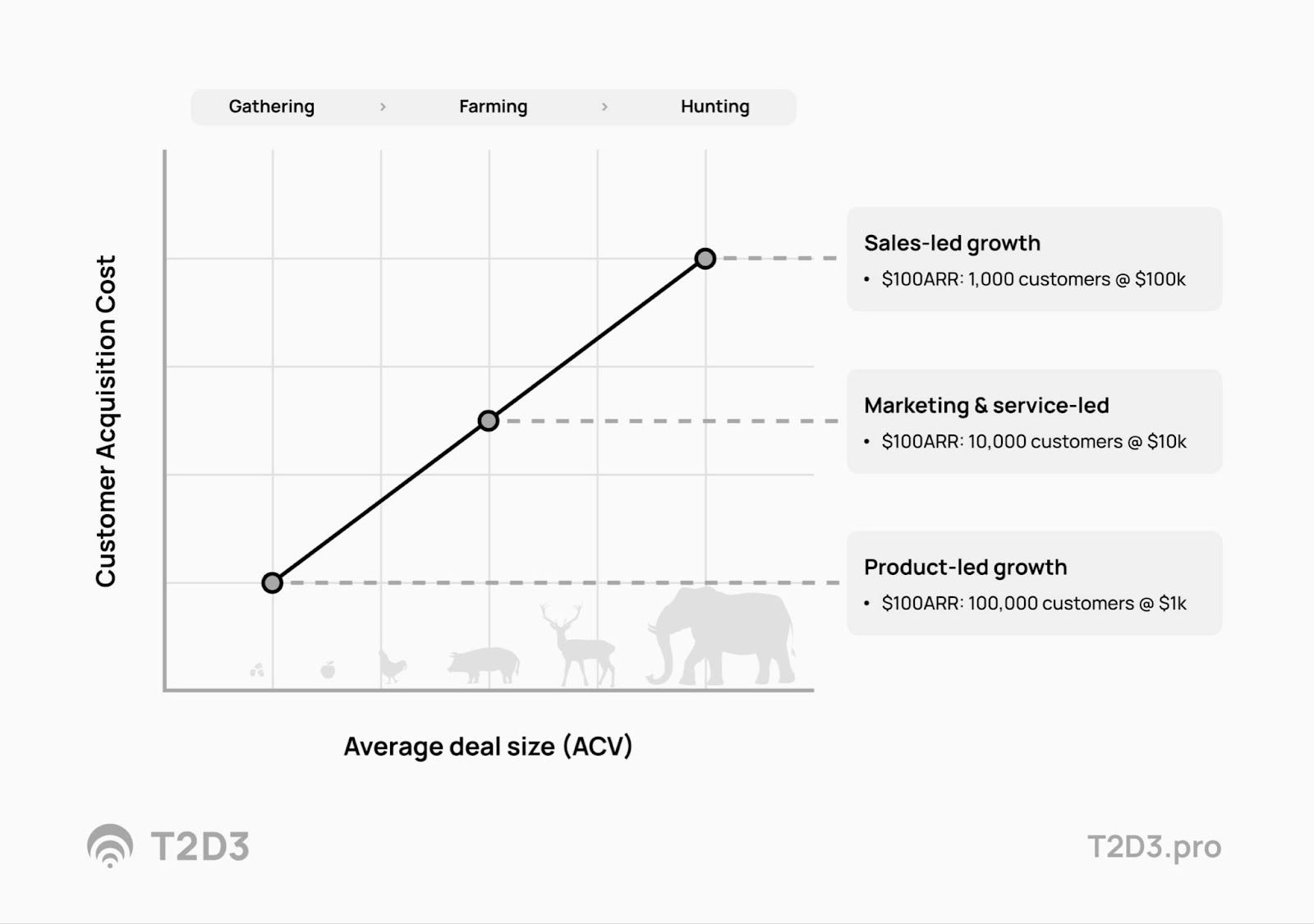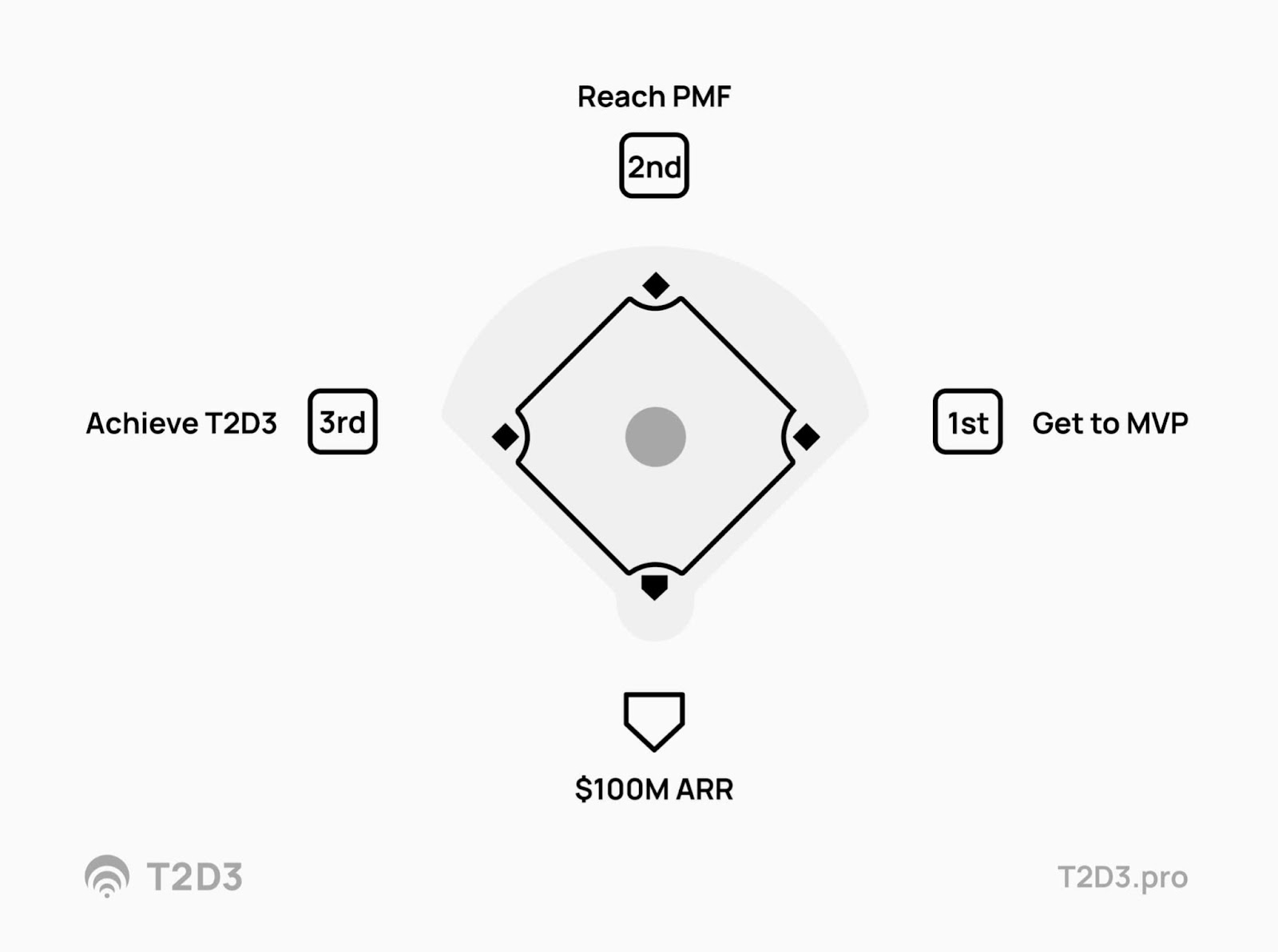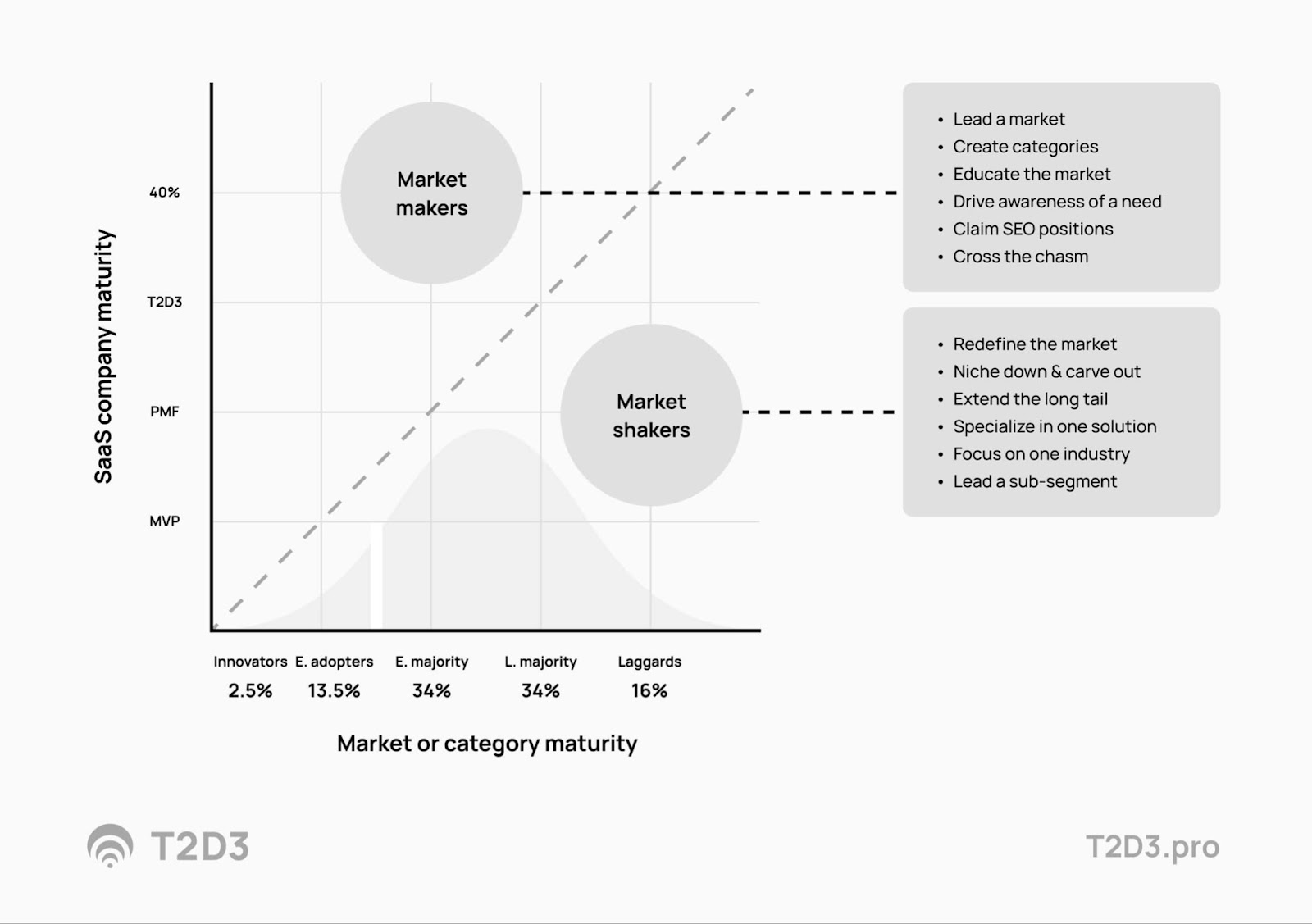The notion of T2D3 growth is an acronym first coined by Neeraj Agrawal from Battery Ventures back in 2015. There were a couple of blog articles on it, but little else. So I’ve compiled some “cheat codes” - or best practices - that I’ve learned over the years.
What's challenging is when you look at all the literature and SaaS marketing playbooks out there, there’s a lot of coverage on the earlier stages of SaaS growth (i.e., how do you get to MVP? How do you get started zero to one?). However, finding resources on what to do in the next stage (i.e., how do you turn that growth into exponential growth?) is more difficult. There's a lot of depth surrounding that topic that is difficult to capture in one book, and I'm not going to pretend that I've been able to, but I've touched on a couple of the most important.
Challenge
The challenge is to do a lot of things in parallel. You can get to MVP and to Product Market Fit (PMF) by finding one demand lever that really works to get extreme loyalty from your customers and them driving referrals. That's how you can get to a couple million in ARR. Maybe even sometimes to 10 million in ARR by mastering one thing, one part of the market, one beachhead, and nailing that. However, to get to 20, 30, 50, or 100 million ARR, there's no way to do that without mastering all the things in the T2D3 formula at the same time.

The example above is not necessarily mathematically correct, but it gives you a sense of when you need to go beyond 5 or 10 million ARR. To reach this higher scale velocity, you need to do a lot of things in parallel: demand gen, diversification, and conversion optimization across the full funnel (not just marketing, but sales, renewals, expansion, price strategy, upsell, cross-sell, etc.). If you get bigger and bigger, the cost to service becomes very important for profitability. All of that of course while you keep churn numbers at the level that it's healthy for the market segment you're in. This is hard.
It's especially hard when companies that receive series A funding are about to go on this part of the journey. With all those new resources they may do a lot of things in parallel that is not being managed correctly. It's good to do a little experimentation. You want to go fast, but you don't want to burn through all your resources by learning on the job.
ARPU - A Good Starting Point
If you're doing your due diligence on an investment, or you're trying to pinpoint where a company is struggling, I always find this picture very helpful.

It directs you towards answering the following questions:
- How is your go-to-market strategy (the market engine - whether it’s a sales-led model, a product marketing, or a product-led growth model) related to the ACV that you think your product can demand from the market?
- What is the ARPU, the revenue per unit (the unit being per customer, usually, or per user)?
There are just some rules of thumb here. For example, if you have a sales-led growth model and you're investing in hiring a relatively expensive sales team, that is extremely hard to sustain unless your average deal size, your average selling price in the first year, is over $100,000. Marketing-led growth runs into the same issues. If you want to buy clicks from Google, compete for high organic search ranking positions, do inbound through sponsorships, event marketing, etc., it quickly becomes expensive. Unless you can command an ACV of, let’s say, $10K, it's extremely hard to actually fund that GTM for a longer period of time.
That doesn't mean you cannot get off the ground with those strategies, but your longer-term vision has to include how you will make those economics work.
The MVP & PMF Milestones
Another vital part of the equation - and one of the things that are helpful for me to assess where a company is on its growth journey - is whether they have achieved Minimum Viable Product (MVP) or Product Market Fit (PMF).
How do you know where you are? MVP is about having a couple of paying customers, or specifically, customers who pay with their time and who help you build your product. PMF is about multiple customers, who pay and stay and maybe even attract early adopters who start referring others. So MVP is about people voting with their feet and with their time and PMF is more about voting with economic things you can measure. You need to know if you have actually reached product-market fit before you can double down and do the investments that are required to get to T2D3 growth.

You will have to understand what your Ideal Customer Profile is based on your PMF milestone before you pour a whole bunch of money into trying to win a certain market segment or investing in a certain GTM model. T2D3 is about doing all those things at the same time to drive revenue, expansion, demand, diversification, retention, and building a customer success function - and all those things are going to be costly. It's important that these efforts are only after you've reached product market fit. That's why I use the baseball diamond as a visual here. You cannot go from second base to home plate. You need to round all the bases in order.
Cheat Sheet for PMF
This is the cheat sheet that I use when I have a limited amount of time to get familiar with a company.

These numbers are far from perfect and are really a very rough sort of categorization. But they allow a quick snapshot and answer questions like “What's your ARR?” or “How big is your team?"
There's an interesting row here. The top line stems from a McKenzie study and measures how many B2B SaaS companies actually make it to each of these milestones.
To do a more detailed assessment of where a company is on its journey, I follow the checklist below (boxes and checkmarks are simply an example here, and will change based on circumstances).

This list asks important milestone questions like:
- Are we already getting customers to refer others?
- How many paying customers do we have?
- How many customers are paying but churn?
All those things are interesting to see where a company fits and then what else is there to do for them to complete a certain milestone and finish that PMF journey.
Determining Market Maturity
What often is forgotten when you do an assessment of where you are, and what's the right go-to-market strategy, is how mature the category itself is. There are many ways to think about this. I like to use the Geoffrey Moore “crossing the chasm” model. You have to ask, "Hey, is this a mature market where I can name the category? Do I know what kind of market I am actually competing in?”

In a mature market, you'll see more PE activity, M&A activity even. When you try to sell, customers want references. They may even ask for a discount. There are all these things that are good indicators that a category is relatively mature. That's a very different place to be in as a startup, as a B2B sales venture, as opposed to an immature market where you have to do some of the education.
In an immature market, you might be the first actually to solve a certain problem that might not even have been defined. The cost of educating the market is high. It's probably cheaper for you to buy clicks. It's easier to compete for organic search positions. There are all these things that are huge advantages of an immature market, but it's also costlier. It's really important to realize where you are.
I like to kind of combine these two dimensions. One is the vertical axis that you see in this illustration that asks “have I reached product market fit?” This is about you, as a company. Am I ready to pour gasoline on the fire and go into T2D3 growth mode? While also accounting for how that relates to the maturity of the category that you’re in.

If a category is very mature, and you are a new entrant who's going to disrupt this category with a completely new pricing model, like what Canva did in the Adobe market, the economics will be vastly different from trying to do the same thing in a younger category. In a mature market, the price of buying a Google click will be very high. It might not even be economical to do so. It will be hard to compete for organic search positions. Driving organic growth and great content marketing will be very different than if you are in a new category, an immature market, where you have a lot of white space. In an immature mature, you can easily buy clicks for a low price, because nobody's competing for those yet.
In both scenarios, you could be the market infant who's just reached PMF and is ready to double down and comes with 10 million in series A funding and is ready to really invest. If you get through the T2D3 growth curve early enough in the category maturity, you might make it. You might be first and maybe were able to win a big beachhead, built out that beachhead and T2D3 growth would be the proof of that. Now, you're well positioned to dominate a category, to be what's called the market maker, where you set the rules.
The market maker determines the price that people pay, how a problem gets named, how it's positioned, and how the market gets defined. It's phenomenal, but you have to be fast. You have to be first in the younger market. This doesn't happen a lot.
What is far more common is that you're shaking up an existing market, either through differentiation or a disruption play. Back to the Canva example, they disrupted an existing market by providing a solution that is servicing a part of that market that is over-serviced. Adobe had a lot of design customers and consumers who were not design specialists and for whom the Adobe toolset was too rich and too much. Canva really played into that with a disrupt play - a different price level, an easier-to-use product, etc. That disrupt strategy is very distinct from a differentiation play where you see companies compete with Adobe (like Figma or Miro).
When you get to product market fit and you're about to double down and go to T2D3 growth you must make the decision of who you want to be. Do you want to disrupt? Do you want to differentiate? It's extremely important. I've seen a lot of companies get funded and they try to do both at the same time to go to the next stage. That's definitely not a recipe for success.
Inbound vs Outbound
I've seen early-stage companies either bet on inbound or outbound, but it's really hard to do one and not the other and succeed. When you're early stage, you need to knock on some doors. So of course, I believe in inbound, but if you just build content and you hope people will find you in a search engine when they're not even aware that there's a problem to be solved, it's going to be hard. So you need to do some outbound. If you only do outbound, then your economics won't work over time.

It's just too costly, especially when you haven't figured out exactly what the ICP is. You're not able to do the laser targeting that you need to do to be able to do outbound effectively. The reality is that most companies will need a funnel that comes from both inbound and outbound.
Really important that when you invest in this sort of two-tier approach, where you have both outbound and inbound, you realize that a traditional outbound is probably not going to work. You need to avoid simply spamming people with content (emails or LinkedIn Messages) that are simply ignored. The proper way is really through what's called Account Based Marketing (ABM). This method is not actually defined by everybody the same way, but for me, ABM is really about figuring out a way to meet people earlier in their journey, especially when you know what the ICP looks like. You can do it extremely targeted to a list of ideal customer prospects and have a fantastic programmatic way to reach out to them in a helpful, non-spammy way. An approach that adds value and is not a sales conversation.
Levers to Drive ARR
If I could summarize all of these “T2D3 cheats” into one illustration, it would be this one. You have to utilize all three levers (monetize, retain and win) to drive ARR for a modern B2B SaaS company.

It’s very easy for companies to get too focused on the box on the right, funnel size. Getting more MQLs, and more conversions of those MQLs to new customers is extremely important. Those are usually the growth levers that are easiest to describe, easiest to find, and easiest to define. But the reality is when you look at long-term ARR impact, the box on the left, this lever has 4X the impact on ARR growth than the box on the right. Make sure that you continue to expand existing accounts by getting more people to use the software within that account. I call this sort of growth unit penetration.
In ARPU, the U stands for units. So how do you get more units? Could be devices, users, seats, depending a little bit on the pricing model, but then of course also increase the actual revenue per unit. Pricing, innovation, upsell, cross-sell, all those things you do to get the individual unit to become more profitable for you. Finally, the middle lever addresses churn. Everybody knows that churn is probably the most important metric for most SaaS companies. That is not something you want to measure in hindsight, you want to manage the leading indicators of churn as early as possible.
So when striving for T2D3 growth and following a balanced SaaS growth playbook, having strength in all three areas and spending a lot of time on the left two levers is really important.